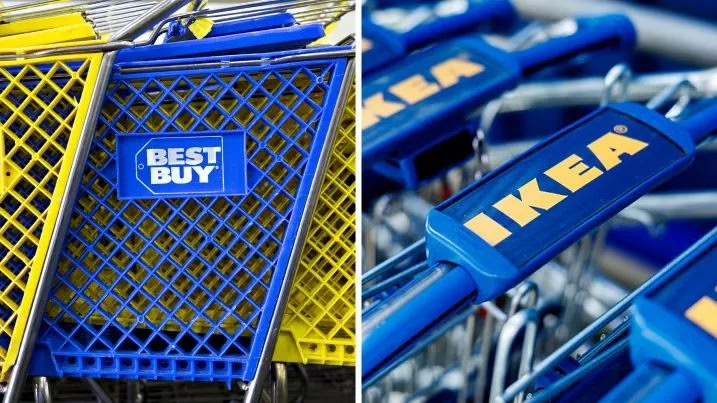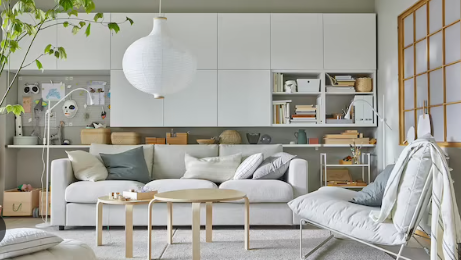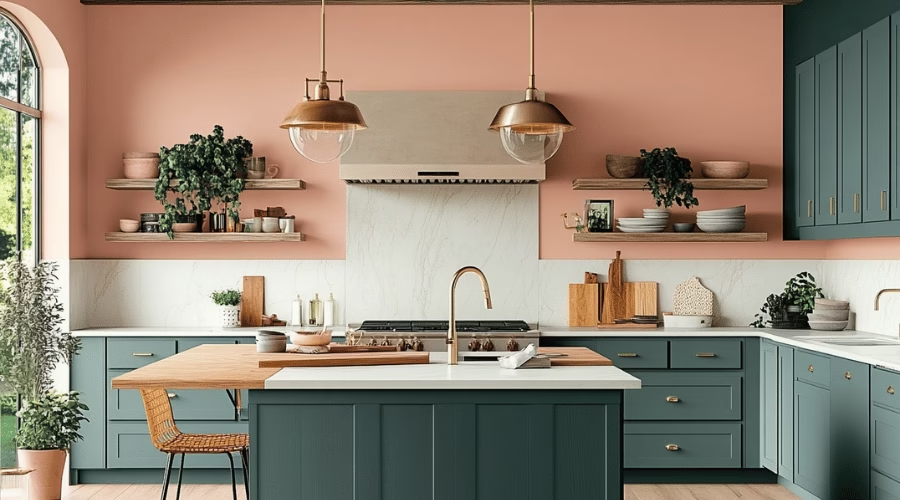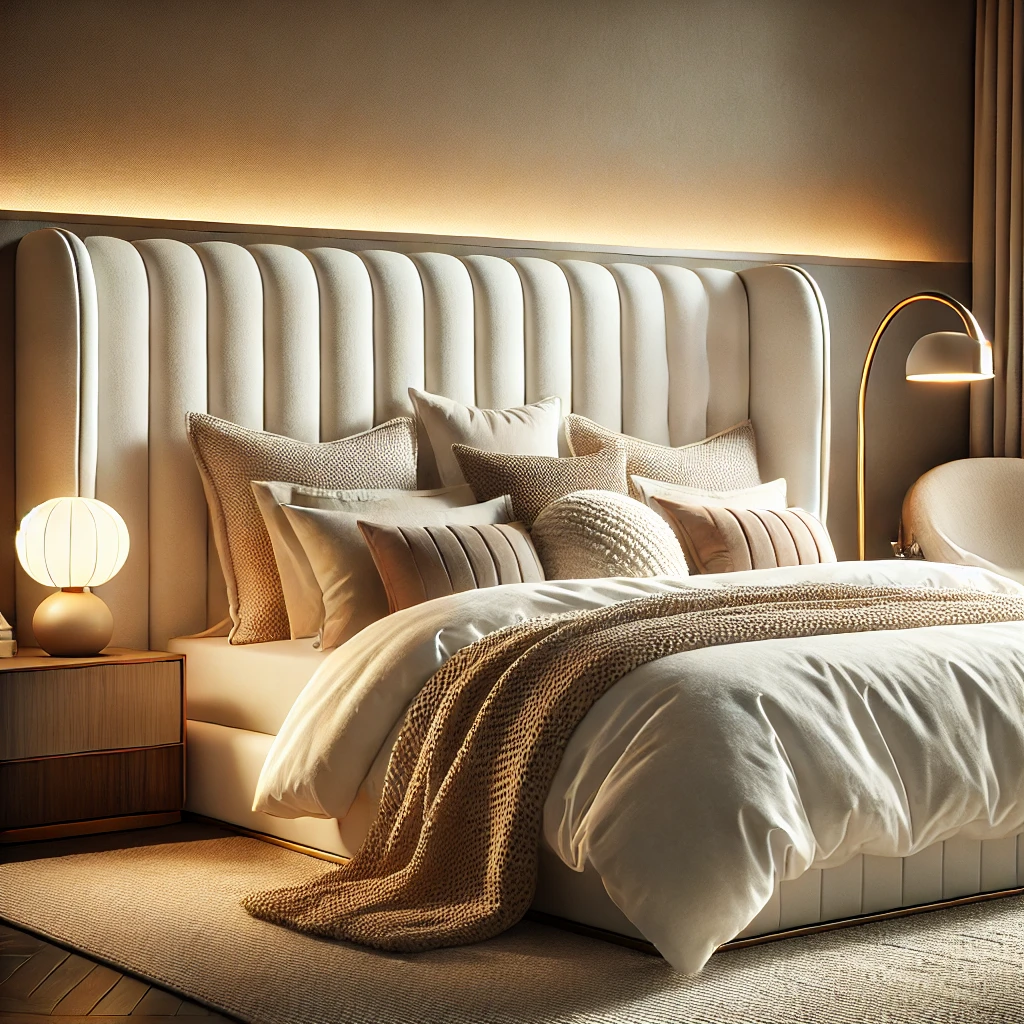A major retail partnership was announced in summer 2025: Best Buy and IKEA U.S. have been partnered to pilot in-store “Planning Centers” (also described in coverage as “shop-in-shops,” “mini-showrooms,” or “planning studios”) inside select Best Buy locations. The pilot was designed to bring IKEA’s kitchen and home-storage planning services together with Best Buy’s appliance and smart-home expertise under one roof.
Executive summary (what was announced)
- A pilot program was announced that will place IKEA planning and ordering experiences inside 10 Best Buy stores across Florida and Texas starting in fall 2025. The program was described by both companies as a pilot to test demand and logistics.
- Each in-store footprint was stated to be approximately 1,000 square feet and will be presented as kitchen and laundry room vignettes designed to help customers visualize full-room solutions combining IKEA furnishings with Best Buy appliances and technology.
- Two of the Best Buy pilot locations — Lakeland, Florida and Alamo Ranch, Texas — were designated to also function as IKEA pick-up points for most IKEA U.S. orders, enabling customers to collect online purchases locally.
- The collaboration was framed by both retailers as a one-stop solution that would make the home-renovation and appliance-buying journey easier for customers by combining design, planning, and appliance advice in a single visit. Executive quotes were included in company communications to emphasize convenience, discovery, and cross-category inspiration.
What exactly will be put inside Best Buy stores?
The physical concept
The program will be implemented as shop-in-shop planning centers, each of which was described as occupying roughly 1,000 square feet inside an existing Best Buy footprint. Within that space, IKEA-styled room vignettes for kitchens and laundry rooms will be installed — including cabinetry, storage solutions, and styling — while Best Buy will display and advise on large appliances and smart-home products that pair with those rooms. In short, a customer will be able to see how an IKEA kitchen or laundry solution looks and then discuss compatible refrigerators, ranges, dishwashers, washers/dryers and smart devices with Best Buy staff on the spot.
Services offered
- Planning and design consultations will be staffed by IKEA specialists who can help customers design kitchens, storage systems, and laundry room layouts to fit their spaces.
- Best Buy staff will be available to consult on appliance selection, installation questions, connectivity, and smart home integration.
- In participating stores, customers will be able to place IKEA orders (which will be fulfilled via IKEA’s standard delivery channels, and in two pilot locations via in-store pickup). The intent was to allow customers to create whole-room plans and then convert those plans into purchases — whether of appliances from Best Buy or furniture and fixtures from IKEA.
Visual and experiential approach
The mini-showrooms were described as immersive, with fully staged room vignettes that will help customers visualize real installations in a home context. These vignettes will be arranged to showcase how design and technology can be combined, for example, a sleek IKEA kitchen paired with a Wi-Fi connected oven, a smart refrigerator, or integrated laundry appliances whose specifications and installation needs can be explained by Best Buy associates. The approach is consistent with IKEA’s small-format planning studios that were rolled out in various markets in recent years and with Best Buy’s long history of store-within-a-store partnerships with brands like Apple and Samsung.
Where will the pilot run? (the 10 locations)
The pilot will be launched across 10 Best Buy stores in Florida and Texas. Multiple reputable outlets and the company releases listed the specific Best Buy locations that were selected for the pilot. The ten stores are:
- Boynton Beach, Florida
- Daytona Beach, Florida
- Lakeland, Florida (will also pilot IKEA pick-up)
- Melbourne, Florida
- Waterford Lakes (Orlando area), Florida
- Alamo Ranch, Texas (San Antonio; will also pilot IKEA pick-up)
- Hulen (Fort Worth), Texas
- Humble, Texas (Houston area)
- Mesquite, Texas (Dallas area)
- South Austin, Texas
This list was published in the official company communications and was repeated by national and industry press. The choice of Florida and Texas as initial markets was explained by commentators as sensible from a housing and renovation demand perspective.
Why this partnership — strategic rationale (what each side gets)
IKEA’s perspective
IKEA’s U.S. expansion and omnichannel strategy were being accelerated in the mid-2020s with an emphasis on smaller, city-friendly touchpoints (planning studios, plan-and-order points, click-and-collect hubs) that avoid the cost and land needs of full-scale large-format stores. By partnering with an established national retailer that already operates in many municipalities, IKEA’s reach was expected to be expanded quickly without the time and capital required to build full stores. Additionally, IKEA’s “planning” format (which focuses on consultation and ordering rather than immediate take-home purchases) was well suited to a shop-in-shop approach where the customer journey is consultative rather than impulse-purchase driven. In short, IKEA’s presence was planned to be scaled faster and tested in new markets via another retailer’s footprint.
Best Buy’s perspective
Best Buy’s appliance and home-technology businesses were an important part of revenue and margin mix, and in recent years the company had invested heavily in services, installation, and smart home integration. By adding IKEA’s room-planning expertise and accessible furnishing assortment, Best Buy was expected to increase the value proposition for customers who seek full-room upgrades rather than standalone appliances. The cross-category nature of home renovations — where furniture, storage and appliances are often purchased together — suggested that a combined experience could drive higher average order sizes, more meaningful consultations, and concurrency in purchases (e.g., new kitchen cabinets + new smart appliances). Moreover, Best Buy’s store-within-a-store experience was already well proven with other vendor partnerships; the IKEA pilot was an extension of that playbook into home furnishings.
Joint benefits
- A “one-stop” design and purchasing funnel was promised to reduce friction for customers who traditionally have to visit multiple showrooms and websites (appliance stores, furniture stores, kitchen showrooms).
- Store traffic could be increased by invoking cross-category discovery. For example, appliance shoppers might see a staged IKEA kitchen and be inspired to consider a coordinated design; IKEA customers might be exposed to Best Buy’s smart home tech.
- Both retailers would benefit from learning: IKEA on how to integrate its services via partner retail footprints in the U.S.; Best Buy on how to integrate design consultation and merchandising that is typically outside its core competency.
Operational considerations and logistics
Staffing and cross-training
It was indicated that IKEA employees will be present inside the Best Buy spaces to provide design and planning services, while Best Buy employees will continue to operate in the appliance and electronics categories. Cross-training and clear service boundaries were implied by the announcement; however, the precise staffing model (how many IKEA planners per store, scheduling, peak-hour coverage) will be determined during the pilot and was not fully disclosed in the first wave of announcements.
Fulfillment and pickup
Two pilot locations (Lakeland, FL and Alamo Ranch, TX) were called out as being able to serve as IKEA pick-up points for most IKEA U.S. orders. This meant that customers who ordered online from IKEA could pick up certain items at those Best Buy stores without extra fee, providing a hybrid fulfillment capability. For other pilot locations, IKEA orders were expected to be fulfilled via IKEA’s normal delivery channels, though customers could place orders while on site at Best Buy’s planning centers. The pickup integration in two stores was viewed as an important logistic experiment to learn how inventory handoffs and last-mile operations could be coordinated between the retailers.
Returns, warranties and installation
Detailed mechanics for returns, exchanges, and warranty handling across the two brands were not fully specified in initial public communications. It was expected that IKEA’s returns and delivery policies would continue to apply to IKEA purchases, while Best Buy’s policies would apply to Best Buy purchases, and that the companies would build a customer service escalation flow for hybrid purchase scenarios (e.g., an IKEA cabinet that requires coordination with a Best Buy-recommended appliance installation). Those operational details were slated to be flushed out during the pilot.
The pilot in context — precedents & industry trends
IKEA’s small-format and planning studio evolution
IKEA’s “planning studio” and plan-and-order concepts had been piloted and rolled out in multiple international markets and some U.S. city centers over recent years. These formats were intentionally small, consultation-focused, and designed for urban shoppers who cannot or do not want to visit large out-of-town IKEA megastores. Thus, the Best Buy partnership was consistent with IKEA’s broader small-format strategy — albeit the first time IKEA had allowed another U.S. retailer to host its product and planning services inside its stores at scale. The smaller format allowed IKEA to be more flexible and present in dense population areas without traditional store capital investments.
Best Buy’s store-within-a-store history
Best Buy has long accommodated brand shops and vendor spaces (for example, Apple, Samsung, and Microsoft zones in many stores). The strategy had been used to deepen product storytelling and provide brand partners the ability to create elevated experiences. Therefore, the IKEA collaboration was an extension of a known strategy: Best Buy’s core operations and customer flow could be leveraged to test other categories that logically intersect with appliances and electronics.
Broader retail trends being addressed
Several retail trends were being tackled by this partnership:
- Omnichannel convenience: Customers increasingly expect a seamless blend of inspiration, planning, and convenient fulfillment. The pilot aimed to reduce the friction in the path from idea to purchase.
- Experience-driven retail: Retailers have been investing in experiences that cannot be replicated online — staged rooms and consultations are hard to duplicate in pure e-commerce.
- Capital-efficient expansion: Brands that want more physical touchpoints without the capital outlay for full stores have been experimenting with shop-in-shop and partnership models. IKEA’s choice to partner with Best Buy was aligned with that logic.
- Cross-category selling: Home renovation projects are naturally cross-category. Encouraging complementary purchases (cabinets + appliances) can increase basket value and customer lifetime value.
Customer experience: what shoppers can expect
Before visiting
- Appointments for IKEA planning sessions could be expected to be bookable, as is common for IKEA planning studios; however, whether appointments would be strictly required or optional was left to pilot store teams to determine.
- Customers could be expected to browse IKEA inspiration and product ranges online and then use the in-store appointment for final planning with a specialist, though walk-in consultation was anticipated to be possible as well.
In store
- Customers would be led through curated room vignettes and could work with an IKEA planner to build a tailored scheme.
- Best Buy specialists could be consulted for appliance compatibility, electrical and installation considerations, and smart home integration.
- Orders could be placed for IKEA products directly from the planning center; in two pilot locations, customers would be able to pick up eligible IKEA orders at the Best Buy pickup point.
After purchase
- Fulfillment, delivery windows, and installation scheduling for appliances would still be handled by Best Buy’s established services. IKEA’s delivery and assembly services would remain available for IKEA purchases (subject to IKEA’s existing policies). The pilot would be used to refine cross-vendor service handoffs.
Business and competitive implications
For large bricks-and-mortar retailers
The pilot had been framed as a test of a more collaborative and modular retail ecosystem: rather than each big brand investing in full standalone stores everywhere, synergies could be unlocked by co-locating complementary services in existing retail real estate. If successful, this model could be replicated by other categories (e.g., furniture + flooring + home tech) and could accelerate similar partnerships.
For national chains and pure-play furniture retailers
Furniture chains and independent kitchen showrooms were expected to monitor the pilot closely. The combination of mass-market IKEA pricing and Best Buy’s appliance selection could be disruptive in markets where buyers prefer an integrated carting experience. Competitors might respond by offering bundled services, stronger online 3D planning tools, or their own partnerships.
For consumers
Consumers were likely to benefit from reduced friction in designing and purchasing multi-category home solutions. The ability to have a single conversation about layout, cabinetry, appliances, and smart connectivity could shorten project timelines and reduce coordination headaches. However, consumers would still need to be mindful of warranty and return boundaries when purchases span two retailers.
Financial angles and scale assumptions
Neither company disclosed financial details of the deal in initial press materials, and launch communications framed the pilot as strategic rather than primarily financial in public messaging. Some analysts and trade reporters noted that even if the pilot increased the average ticket across those ten stores by a modest percentage, the model could be very accretive if scaled across hundreds of stores given Best Buy’s large footprint (Best Buy operates many hundreds of U.S. stores). For IKEA, the capital-light expansion into new markets via partner real estate could reduce customer acquisition costs compared with opening full-sized stores. Both companies were expected to monitor conversion rates, consultation booking rates, and incremental basket effects to determine expansion potential.
Critics’ and analysts’ reactions (early takes)
Early media and analyst commentary was broadly intrigued and cautiously optimistic:
- Many outlets called the idea “logical” and “smart,” arguing that appliances and kitchen furniture are highly complementary categories and that the in-store planning concept could remove substantial friction for customers.
- Some analysts cautioned that operational complexity could be a key risk — particularly around fulfillment, returns, and installation logistics when a customer’s purchase spans two retailers and potentially two service providers. The pilot was therefore seen as a means to learn these operational edges rather than as a model that was guaranteed to scale overnight.
Final analysis — why this matters
This partnership was notable not only because it paired two very different retail specialists — one in home furnishings and one in consumer electronics and appliances — but also because it illustrated a larger shift in how physical retailing is being rethought. Instead of each brand independently increasing its brick-and-mortar footprint, strategic co-location and service integration were being tested as ways to get closer to customers more quickly and with less capital risk.
If the pilot demonstrated strong conversion rates, high customer satisfaction, and smoother logistics, the partnership might be scaled — potentially reshaping how big-box retailers and category specialists collaborate to serve multi-category projects like kitchens and laundry upgrades. On the other hand, if operational headaches or weak conversion metrics emerge, both companies would likely treat the pilot as a valuable lesson in the limits of co-location.
Either way, customers were set to benefit from more options and convenience during the pilot: the ability to imagine a whole room and then to discuss appliance and installation questions in the same visit was being made easier than it had been previously.
Read more trending HOME news here
![]()




Smart bankroll management is key, regardless of the game. Seeing platforms like fc178 com emphasize data & transparency is a positive step for informed players – helps shift focus from luck to strategy! 🤔